Tuesday, July 31, 2012
Monday, July 23, 2012
Rebounding Tips & Techniques
By Joe Haefner
Rebounding is very important. If you rebound well, this allows you to get more possessions throughout the game. The team with the most possessions has a better chance of winning.
When blocking out or boxing out:
After you secure a rebound, you should:
Rebounding is very important. If you rebound well, this allows you to get more possessions throughout the game. The team with the most possessions has a better chance of winning.
When blocking out or boxing out:
|
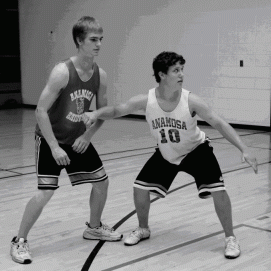 |
|
 |
After you secure a rebound, you should:
- "Chin the ball" which means to put the ball underneath your chin
with your elbows out. This makes it harder for the defense to steal the
ball from you after you secure the rebound.
- Pivot away from the basket to the sideline to throw an outlet pass to a streaking player or a guard located near the sidelines.
If you want to see and hear more of these rebounding tips from Dwight Howard of the Orlando Magic, check out this video:
Sunday, July 15, 2012
PLAY PRESENT
If you want to be the best player (or coach) you can be, you have to
learn how to PLAY PRESENT. You have to learn how to focus on the 2
things you have complete control over (your attitude and your effort).
You have to learn now to focus on the process, not the outcome. And you
have to learn how to focus on the next play. The ability to 'play
present' is the definition of mental toughness.
This poem was posted by Alan Stein on his Stronger Team Blog.
Here is what he had to say about getting the importance of one possession across to your players. One of the
key concepts of ‘Playing Present’ is the ability to focus on the next
play, the play right in front of you. On defense that means that this
stop is the only stop that matters. This stop is the most important stop
of the entire game. The same is true on offense. This possession is
crucial. We need to get a great shot on this possession. Players and
teams who master ‘Playing Present’ will maximize their basketball
ability.
This poem below sums up the ‘Playing Present’ concept perfectly:
One Possession poem:
It was only one possession,
Why does my coach scream?
My poor ‘D’ allowed a basket,
But what does one hoop mean?
As the pass comes my direction,
I fumble it into the stands,
My coach’s voice rings loud and clear,
“Always use both hands!”
C’mon coach, its one possession,
Our team will be OK,
It’s just the first two minutes,
I mean damn, we’ve got all day!
In the beginning of the 2nd quarter,
Their center is strong and stout,
He scores an easy two, quite simply due,
From my failure to block out.
It was only one possession,
I didn’t commit a crime,
My team is ahead and I’m playing well,
And there’s still plenty of time!
As the halftime buzzer sounds,
I watch the ball bank in,
I know I will hear it from my coach,
Asking why I don’t defend.
But it was only one possession,
Coach – don’t have a heart attack,
We’re only down one and we’re having fun,
I know we’ll get it back!
The 2nd half is much the same,
So it is really no big deal,
That my lazy and careless pass,
Results in an easy steal.
I quickly sink a jumper,
I’m greeted by high fives and slaps,
But the next time down, I give up a lay-up,
While suffering a mental lapse.
It’s only one possession,
C’mon coach just chill out!
It’s crazy to see you so mad,
As you consistently scream and shout:
“Victory favors the team,
Making the fewest mistakes.
Singles possessions are the key,
And will cut down their fast breaks.”
I step to the line for a one and one,
The game is in my hands.
I can’t believe I missed it short,
And hear cheers from their fans.
After the game I pouted,
Knowing what I could have done,
Realizing the value of each possession,
Damn, we lost by one.
Play hard. Play smart. Play Together every possession. - Alan Stein
Wednesday, July 11, 2012
Rebounding Drills
These
Rebounding Drills came from the Arizona Men’s February Basketball
Newsletter.
War Drill (8 minute drill)
(1 basketball. 6. 8 or 10 players. Full Court)
Defense is in the paint and matches up. On the shot by the coach.
their goal is to go meet the offense outside of the paint and keep them
out of it.
The offensive players are set up behind the three point line and
except for the point guard, (who gets back on defense), are going hard
to the rim. The defender on the point guard should look to help on
boxing someone else out.
This is a highly competitive drill with a winner and loser. If the
offense gets the rebound they get a point and can try to score a 2 or 3
pointer. If they score we set the drill back up. If the defense gets
the rebound or forces a turnover, there is no point scored but they push
the basketball down court (transition offense) and try to score on the
other end. On a score or turnover by them, play stops and we set the
drill back up.
The ball will only go from one end to the other end one time and then
the drill would be reset. If we don’t reset the drill it becomes a
transition drill and not a contact drill.
There are no points on a made shot by the coach but it is still played like a rebound.
Thoughts on Rebounding:
• On a 3 point shot, it takes a long time for the ball to get there
• Get out and hit your man, find the ball, and get it
• The greatest rebounders are guys who can range rebound
• They don't just get the rebounds that are coming right to them
Thoughts on Rebounding:
• On a 3 point shot, it takes a long time for the ball to get there
• Get out and hit your man, find the ball, and get it
• The greatest rebounders are guys who can range rebound
• They don't just get the rebounds that are coming right to them
Get to the Basket Drill
(1 basketball, 3 or more players)
Place two defenders side by side facing the offense (if you have
football pads, use them). On the shot, the offense has to bust through
to the basket. This teaches them to never surrender going to the basket
and being aggressive.
Without the pads, the defense gives a little pressure, just enough to make them push through.
Tuesday, July 10, 2012
Some Coaching Bullets to Consider
Del Harris and friends, 2012 (revised from 2009)
Before you start:
Be sure you have a mission statement that is current with your current thinking and then stay committed to that statement. Be sure your staff and players understand your mission.
Make sure your philosophy of coaching, of defense, of offense and of dealing with players and other constituents is clear-cut and understood by yourself and staff and that it matches your mission.
Leave a paper trail. Keep copies of important communications with all relevant parties. Notes, dates and times of any significant meeting with players, media, etc can be of value.
Be sure you have a plan for the first day, week and rough copy for first month of your practices.
Be sure any staff is up to date on current trends in conditioning, nutrition, etc. These change.
Be sure to read current books and old standards on leadership, management skills, time management, significant biographies of important people and successful coaches in any sport. You must continue to grow mentally and spiritually.
Revise your drill book (You have one, don’t you?) to add any new concepts you have picked up and to discard needless ones.
The best drills are the ones you make up that teach specifically the exercise you are trying to teach/correct.
Your drill book should be divided into categories such as: warmup, shooting, fundamentals of offense/defense, fast break buildups for offense and transition defense, half court offense, post offense/defense, trap drills, defense shell drills, situation drills for 1-1, 2-2 and 3-3, game ending situations drills, etc.
Be sure to be clear on all basic defense issues such as you initial and backup coverages relative to pick and roll defense, low post defense, and methods of rotation to cover breakdowns.
Make sure your coaches and players understand the concepts of switching on defense such as which teammates will be able to switch with each other on their own as needed or desired unless the game plan or a timeout changes it. Have switching partners which normally means that equal size players will switch with one another as needed.
Know that the concept of switching to keep your bigger players inside and your smaller ones outside is often very productive, i.e. “Bigs in, Littles out”. Thus you would not switch a big man out off of a downpick or pindown for a small player except in a critical emergency situation.
Your team will reflect what you emphasize. Take your pick, but only about 4 or 5 will be the limit as to what they will attach themselves to, so choose wisely.
1. Defense
2. Rebounding
3. Unselfish play---team unity---team attitude
4. Running game
5. Half court game
6. Pressing team---running team
7. Physical team
8. 3-pt team
9. Zone team
10. Ball and player movement team, etc.
Game Time:
Be sure you have a helpful game card with you at all times such as quarterbacks have on their sleeve or arm.
A good game card will not only have all your play calls, but will have categories that will get you a post up as needed and that tell you what plays you have that will get each position (1 through 5) a shot when you want one of those players to have the ball.
On the back of the card of on a special situations card you can have in your pocket or an assistant will keep be sure to have plays already diagrammed that are for special late game situations such as: when you need a 3 pointer, or a quick 2, or you have differing amounts of time on the clock to get a shot.
Be smart on what you chart and have accountable chart keepers. A possession chart can tell you the pace and momentum of the game because it will tell you how many possessions you have had at every time interval and once you know your best pace, you can tell if you are dictating or if the opponent is.
Momentum is revealed by a possession chart in that it shows how many times you and your opponent have scored or failed to score in the most recent possessions.
Other charted items may be the fast break game on both sides of the ball, the low post game (scores allowed/how traps have worked, etc), the pick and roll game (percentage of scores/stops), deflections, penetrations allowed, uncontested shots allowed, and whatever else you deem to be of real value.
A good game card will not only have all your play calls, but will have categories that will get you a post up as needed and that tell you what plays you have that will get each position (1 through 5) a shot when you want one of those players to have the ball.
On the back of the card of on a special situations card you can have in your pocket or an assistant will keep be sure to have plays already diagrammed that are for special late game situations such as: when you need a 3 pointer, or a quick 2, or you have differing amounts of time on the clock to get a shot.
Be smart on what you chart and have accountable chart keepers. A possession chart can tell you the pace and momentum of the game because it will tell you how many possessions you have had at every time interval and once you know your best pace, you can tell if you are dictating or if the opponent is.
Momentum is revealed by a possession chart in that it shows how many times you and your opponent have scored or failed to score in the most recent possessions.
Other charted items may be the fast break game on both sides of the ball, the low post game (scores allowed/how traps have worked, etc), the pick and roll game (percentage of scores/stops), deflections, penetrations allowed, uncontested shots allowed, and whatever else you deem to be of real value.
As you go along:
“Prove you are valuable and success will happen for you. Forget about the entitlements.”
Be careful of the player who insists he is all about winning, but doesn’t work like a winner. He is usually happy when things are going his way, whether the team is or not.
The team that will accept we over me (we/me) as a group has a chance to achieve all they are capable of.
There is no “I” in team but there is “ME” but it tears up TEAM to get it. META spells disaster for the team; it says that the “ME Trumps All” the rest of the team.
Doc Rivers says to try to keep the “chemistry guy” on your team. Doc moves the lockers around occasionally to keep the right people together or separated as needs be.
Del Harris says to speak to players often, but more on the conversational level than any other. Get to know them and then prove that you care about them. he notes that the Caring-Trust-Loyalty Dynamic is of utmost importance to a successful organization. First show you do care consistently. Caring leads to trust. Trust breeds loyalty and loyalty leads to unity.
Jerry Sloan coaches with the idea that he wants to be a friend of his player/s 20 years down the road. Now you know he is not a softie, but he cares and his players know it. They trust him and are loyal to him and they just find a way to win every year. That is true coaching.
Be careful of the player who insists he is all about winning, but doesn’t work like a winner. He is usually happy when things are going his way, whether the team is or not.
The team that will accept we over me (we/me) as a group has a chance to achieve all they are capable of.
There is no “I” in team but there is “ME” but it tears up TEAM to get it. META spells disaster for the team; it says that the “ME Trumps All” the rest of the team.
Doc Rivers says to try to keep the “chemistry guy” on your team. Doc moves the lockers around occasionally to keep the right people together or separated as needs be.
Del Harris says to speak to players often, but more on the conversational level than any other. Get to know them and then prove that you care about them. he notes that the Caring-Trust-Loyalty Dynamic is of utmost importance to a successful organization. First show you do care consistently. Caring leads to trust. Trust breeds loyalty and loyalty leads to unity.
Jerry Sloan coaches with the idea that he wants to be a friend of his player/s 20 years down the road. Now you know he is not a softie, but he cares and his players know it. They trust him and are loyal to him and they just find a way to win every year. That is true coaching.
Think communication:
Del Harris notes that there are five levels of communication with players—use each one less than the one before it as you go down the levels.
1. Conversational level—you have the give and take whereby you get to know the player and he learns you as well. You demonstrate you care. Use this the most.
2. Encouragement level—voice is animated and enthusiastic. Use it as much as you can, but it has to be a result of real achievement, not just blowing smoke. But the worst person to be with is the one you simply cannot please. Be real.
3. Instructional level—voice is slightly animated as you attempt to pass on teaching points that may help your player get better, or that may help him understand the team concept. Use often, but mostly in practice or in certain 1-1 situations.
4. Correctional level—voice increases somewhat in urgency, but this is not to be confused with screaming. Naturally, this is used on important issues in practices and games to help eliminate errors. Use it as needed, but if it overwhelms the encouragement level, the team will tune you out sooner than later.
5. “Go Nuts” level—yes, there is a place for letting them know that they have crossed the line in terms of lack of effort or execution or attitude, etc. They must know you really care about certain issues. But, of course you must maintain control here, as it should be a purposeful act. Overdo this level and you will lose your team by Christmas unless you are winning every game.
1. Conversational level—you have the give and take whereby you get to know the player and he learns you as well. You demonstrate you care. Use this the most.
2. Encouragement level—voice is animated and enthusiastic. Use it as much as you can, but it has to be a result of real achievement, not just blowing smoke. But the worst person to be with is the one you simply cannot please. Be real.
3. Instructional level—voice is slightly animated as you attempt to pass on teaching points that may help your player get better, or that may help him understand the team concept. Use often, but mostly in practice or in certain 1-1 situations.
4. Correctional level—voice increases somewhat in urgency, but this is not to be confused with screaming. Naturally, this is used on important issues in practices and games to help eliminate errors. Use it as needed, but if it overwhelms the encouragement level, the team will tune you out sooner than later.
5. “Go Nuts” level—yes, there is a place for letting them know that they have crossed the line in terms of lack of effort or execution or attitude, etc. They must know you really care about certain issues. But, of course you must maintain control here, as it should be a purposeful act. Overdo this level and you will lose your team by Christmas unless you are winning every game.
Who is your closer?
You need a “closer” in every business, someone who can seal the deal often. Know who yours are. This is not an equal opportunity situation. Be able to run your stuff to get the ball to the “closer” in need situations.
Do not underestimate the value of a player who can inbound the ball in pressure situations. Lack of this ability will beat you in the close games. The chances are you will have no more than two of these, if you actually have anyone. Develop one.
Every team wants to win the championship. Talk about it on the first day, and then forget the talk until you are playing for it. Your goals must become closer at hand and the main one is to get better every day/game. That is the path to
championships, not talk. And I don’t want to hear that my teams did not win an NBA title. My college teams won 19 championships, we won 3 national titles in Puerto Rico against NBA or D-1 level coaches and won 2 international gold medals. My Lakers team that was the youngest team in the playoffs my final two years (when Kobe was 18 and 19 years old) won 56 and 61 games with Shaq missing 53 of those games due to injury. They ran off 3 in a row two years later.
Most of your players will be role players. Most will think they are key players. As coach you must laud the roles you assign; make them be understood and appreciated. Without the dedicated role players you cannot succeed.
Have simple goals for your role players. Just 1 or 2 stats per quarter can add up to being the difference—a steal, a rebound, a free throw, a deflection, an assist, etc. Just a little goes a long way. Honor your role players as well as the stars.
Check it out—NBA teams seldom have more than 2-3 players who are more than role players—ones who produce consistently across the stat sheet and make others better. The 85+ percent are role players.
Coaches who talk too much in practice can kill the team’s ability/need to communicate among themselves. Coaches who chatter too much give the appearance of working hard but actually stifle the players in developing their own skills of communication. This is true especially of assistants. Hooting and hollering on every pass and cut is not necessarily a sign you are working.
Simplify your teaching and communication. This will reduce confusion. An athlete that is not decisive and confident in what he is to do will be hesitant and a hesitant athlete will fail.
NBA asst. coach Brendan Suhr notes that you must coach each player differently. It’s about their strengths and needs, not yours. Read books: Strength Finders and Strength Finder 2.0.
Identify your leaders and lieutenants. You must connect early with them and get them to understand and promulgate your mission and goals for the team.
The best teams are the ones where the coach and the team leaders are united (requires some ego reduction on part of coach) and these players work the hardest and articulate the team message to others.
It is hard for a general to win without support from within the ranks. Encourage and develop leaders and relationships with them.
Fill up your players “emotional Bank Accounts”. Make 4 deposits to one withdrawal.
Encourage your players to take responsibility. The best ones have often been allowed too much freedom from this at lower levels (i. e., AAU ball) “My Bad” is not sufficient.
You can help, but players must know that they are in charge of their own attitudes, work ethic, enthusiasm, and mental/physical approaches.
Many times I have been asked how a coach gets an NBA player to listen. The answer is that you must be willing and able to help them get better. If you can do that, they will listen because they do want to improve. Once you quit helping them, you can lose them. Keep improving and learning yourself, therefore.
When Hank Haney quits helping Tiger Woods to win, Tiger will get another coach. (This was written in 2009—Hank is gone.)
Learn to read body language to be able better to deal with a player that day.
Watch your own body language in practice and especially during games. Do not slump over at the bench or go goofy when things go wrong or a player makes a mistake. Have enthusiastic or positive approach when appropriate, but stay subdued in the down times. You can go crazy on the team, but that is different than the defeatist, slumped over approach or the throwing your hands up in the air to the crowd as if to say—I am ok, but what is wrong with that player? Stay in control of your body language no matter what you are feeling inside. (Solid advice—hard to do)
Why do coaches react so strongly to a player’s mistakes in many cases? Trust this. It is because the coach wants to divorce himself from that mistake and thus that player at that time. It is his way of telling the fans that it is not his fault. The same coach will give a body language reaction fist pump that says, “That is what I coached him to do” when the player scores.
One of your main goals with each player is to coach him to become the best teammate he can be. When we interviewed a player pre-draft, we always asked him about his relationship to his coaches and to his teammates. When we talked to his coach we wanted to know what kind of teammate he was.
When I coached college, I coined a term called “Teammanship” and in that concept we tried to inculcate things that would honor team membership and encourage team building. (On one occasion for each of my two top scorers I had to put them to the brink of elimination in order to get them to know I was serious. Thankfully, both stayed but one came in the day before he was to enroll at another college to tell me he wanted to come back and be a good team member. He led the team in scoring and we went 25-3, 6th in nation).
When my first of two college teams that were inducted into their own Hall of Fame en masse, all 13 players came from as far as Europe to be there. The one who came from England was the one I mentioned in the previous point. I had started with that team nearly 35 years previously to their induction, but they were still a team.
Other books of value—The Outliers, The Talent Code (maybe the best relative to teaching/coaching technique I have ever read), Training Camp by Jon Gordon, Leadership Secrets of Attila the Hun (great quick read), Red and Me by Bill Russell, Talent is not Enough by John Maxwell (any of his leadership books such as the Servant Leader, etc.), the magazine entitled SUCCESS, and many more.
My own book, On Point—4 steps to better life teams is obviously one I believe in for great team building that leads to lasting relationships—worth more than trophies. See www.OnPointLifeTeam.com for review.
Allow enough shooting time. Still the most singly important factor in the game. Bad plays look good when ball goes in and vice versa.
Encourage your shooters to get in their 300 or so reps every day. Nowitzki and Nash and then Jason Terry got in 500 every day---every day—and they are the best for obvious reasons.
These players came into the NBA as poor shooters—Jordan, Dr. J., and Clyde Drexler and they became Hall of Famers and good shooters. Most players become much better shooters in the NBA due to reps. Check any player’s career stats.
If a player comes into the league as a rebounder or a steals guy, he will rebound and steal in the league. The only stat that players consistently get better at is shooting and it is because they get more reps as a pro.
Defense is the difference in championship games normally. But while defense may win a championship for you, you will never get a chance to find out, if you cannot score.
The thing that makes for a bad team in the NBA (remember that every one of these players was the best on his HS and college team in most cases) is the inability to score.
Avoid trying to keep your team at half court too much thinking that you can stop them and do more teaching. The game is played full court.
Too much time at half court will stifle a teams fast break game as the initial reaction to go to the other end is the difference in a successful break most often.
A team that spends too much time at half court teaching will not be as good a transition defensive team as it needs to be in most cases.
So, do more scrimmage-like situations but control the scrimmages and fulfill what you want as a teacher and what the team needs for transition offense and defense.
Best scrimmage teaching drills are starting with a specific situation at half court and then letting there be that possession and two more. This three-possession game is called O-D-O for Offense-Defense-Offense. On the second and third possession the teams can do whatever comes up, as that is the way the game is played.
Limiting the scrimmage to three possessions allows you to teach the pluses and minuses of the three possessions better because everyone can remember that short of a series.
Drill also some 5-possession games and do the same way. You start with a controlled half court and then the players play out four more possessions, ending up on the end they started. The game is generally played in spurts of no more than 5 possessions before a whistle is blown and this allows game feel and coach control.
Be inventive with these controlled sessions. Have each possession be only with 10 seconds; or have them run a particular set when they don’t have a fast break; or have them go vs. man/man some and zone on other sets; and start the initial possession from out of bounds needing a 3 or needing a quick 2 or running the clock etc.
You can score these by giving a point for a score and a point for a stop. With 3 possessions (or 5) there will always be a winner since there are an uneven number of points available. The winner of each one can start the next set if you want. Or you can keep track of the number of sets each team wins to determine a winner. Award the winners.
You never waste time when you do the defensive shell drills.
Remember that you must emphasize defense, but offense is more involved because it involves ball skills and exact timing. Thus, offense takes more time.
I always doubt coaches who say they spend far more time on defense than offense. Why would you do that when offense requires much more teaching and time? And why ignore offense when teaching defense---the guys on both sides of the ball are on your team when you are teaching defense, unless you spend the whole time running slides against air. Air is not the enemy—good to remember in all defenses, especially when in a zoning situation on the weak side or when the team is in a regular zone defense.
Hopefully, anyone should realize that you could teach both offense and defense at the same time. So teach both at the same time. If you cannot, have an assistant focus on what you are not focused on and let him talk.
Even in the most dedicated of offensive drills, if a player does well or poorly on defense, you cannot overlook that. More time on offense, more emphasis on defense.
Your team will reflect what you emphasize. (worth repeating)
You are an offensive or defensive coach relative to what upsets you. If you say you are a defense coach but never sub for poor defense by your better players, you are not a defense coach. (If he is really good, you don’t have to leave him out for long—you made a point).
If you are an execution coach but don’t get upset at the lack of execution, then you really are not what you say you are.
Summary Note
Over the years your teams will be identified by about 3-5 things that they do well—not 10-15 things. Those are the things you teach well and that are important to you.
With the great coaches you always know what their teams will do well. So decide how you want to be typified and stick with that as long as you are successful. Make subtle changes as you go, but stick with your winning core.
Del Harris, GM Texas Legends, NBADL
dharris@texlegends.com
www.OnPointLifeTeams.com
Do not underestimate the value of a player who can inbound the ball in pressure situations. Lack of this ability will beat you in the close games. The chances are you will have no more than two of these, if you actually have anyone. Develop one.
Every team wants to win the championship. Talk about it on the first day, and then forget the talk until you are playing for it. Your goals must become closer at hand and the main one is to get better every day/game. That is the path to
championships, not talk. And I don’t want to hear that my teams did not win an NBA title. My college teams won 19 championships, we won 3 national titles in Puerto Rico against NBA or D-1 level coaches and won 2 international gold medals. My Lakers team that was the youngest team in the playoffs my final two years (when Kobe was 18 and 19 years old) won 56 and 61 games with Shaq missing 53 of those games due to injury. They ran off 3 in a row two years later.
Most of your players will be role players. Most will think they are key players. As coach you must laud the roles you assign; make them be understood and appreciated. Without the dedicated role players you cannot succeed.
Have simple goals for your role players. Just 1 or 2 stats per quarter can add up to being the difference—a steal, a rebound, a free throw, a deflection, an assist, etc. Just a little goes a long way. Honor your role players as well as the stars.
Check it out—NBA teams seldom have more than 2-3 players who are more than role players—ones who produce consistently across the stat sheet and make others better. The 85+ percent are role players.
Coaches who talk too much in practice can kill the team’s ability/need to communicate among themselves. Coaches who chatter too much give the appearance of working hard but actually stifle the players in developing their own skills of communication. This is true especially of assistants. Hooting and hollering on every pass and cut is not necessarily a sign you are working.
Simplify your teaching and communication. This will reduce confusion. An athlete that is not decisive and confident in what he is to do will be hesitant and a hesitant athlete will fail.
NBA asst. coach Brendan Suhr notes that you must coach each player differently. It’s about their strengths and needs, not yours. Read books: Strength Finders and Strength Finder 2.0.
Identify your leaders and lieutenants. You must connect early with them and get them to understand and promulgate your mission and goals for the team.
The best teams are the ones where the coach and the team leaders are united (requires some ego reduction on part of coach) and these players work the hardest and articulate the team message to others.
It is hard for a general to win without support from within the ranks. Encourage and develop leaders and relationships with them.
Fill up your players “emotional Bank Accounts”. Make 4 deposits to one withdrawal.
Encourage your players to take responsibility. The best ones have often been allowed too much freedom from this at lower levels (i. e., AAU ball) “My Bad” is not sufficient.
You can help, but players must know that they are in charge of their own attitudes, work ethic, enthusiasm, and mental/physical approaches.
Many times I have been asked how a coach gets an NBA player to listen. The answer is that you must be willing and able to help them get better. If you can do that, they will listen because they do want to improve. Once you quit helping them, you can lose them. Keep improving and learning yourself, therefore.
When Hank Haney quits helping Tiger Woods to win, Tiger will get another coach. (This was written in 2009—Hank is gone.)
Learn to read body language to be able better to deal with a player that day.
Watch your own body language in practice and especially during games. Do not slump over at the bench or go goofy when things go wrong or a player makes a mistake. Have enthusiastic or positive approach when appropriate, but stay subdued in the down times. You can go crazy on the team, but that is different than the defeatist, slumped over approach or the throwing your hands up in the air to the crowd as if to say—I am ok, but what is wrong with that player? Stay in control of your body language no matter what you are feeling inside. (Solid advice—hard to do)
Why do coaches react so strongly to a player’s mistakes in many cases? Trust this. It is because the coach wants to divorce himself from that mistake and thus that player at that time. It is his way of telling the fans that it is not his fault. The same coach will give a body language reaction fist pump that says, “That is what I coached him to do” when the player scores.
One of your main goals with each player is to coach him to become the best teammate he can be. When we interviewed a player pre-draft, we always asked him about his relationship to his coaches and to his teammates. When we talked to his coach we wanted to know what kind of teammate he was.
When I coached college, I coined a term called “Teammanship” and in that concept we tried to inculcate things that would honor team membership and encourage team building. (On one occasion for each of my two top scorers I had to put them to the brink of elimination in order to get them to know I was serious. Thankfully, both stayed but one came in the day before he was to enroll at another college to tell me he wanted to come back and be a good team member. He led the team in scoring and we went 25-3, 6th in nation).
When my first of two college teams that were inducted into their own Hall of Fame en masse, all 13 players came from as far as Europe to be there. The one who came from England was the one I mentioned in the previous point. I had started with that team nearly 35 years previously to their induction, but they were still a team.
Other books of value—The Outliers, The Talent Code (maybe the best relative to teaching/coaching technique I have ever read), Training Camp by Jon Gordon, Leadership Secrets of Attila the Hun (great quick read), Red and Me by Bill Russell, Talent is not Enough by John Maxwell (any of his leadership books such as the Servant Leader, etc.), the magazine entitled SUCCESS, and many more.
My own book, On Point—4 steps to better life teams is obviously one I believe in for great team building that leads to lasting relationships—worth more than trophies. See www.OnPointLifeTeam.com for review.
Allow enough shooting time. Still the most singly important factor in the game. Bad plays look good when ball goes in and vice versa.
Encourage your shooters to get in their 300 or so reps every day. Nowitzki and Nash and then Jason Terry got in 500 every day---every day—and they are the best for obvious reasons.
These players came into the NBA as poor shooters—Jordan, Dr. J., and Clyde Drexler and they became Hall of Famers and good shooters. Most players become much better shooters in the NBA due to reps. Check any player’s career stats.
If a player comes into the league as a rebounder or a steals guy, he will rebound and steal in the league. The only stat that players consistently get better at is shooting and it is because they get more reps as a pro.
Defense is the difference in championship games normally. But while defense may win a championship for you, you will never get a chance to find out, if you cannot score.
The thing that makes for a bad team in the NBA (remember that every one of these players was the best on his HS and college team in most cases) is the inability to score.
Avoid trying to keep your team at half court too much thinking that you can stop them and do more teaching. The game is played full court.
Too much time at half court will stifle a teams fast break game as the initial reaction to go to the other end is the difference in a successful break most often.
A team that spends too much time at half court teaching will not be as good a transition defensive team as it needs to be in most cases.
So, do more scrimmage-like situations but control the scrimmages and fulfill what you want as a teacher and what the team needs for transition offense and defense.
Best scrimmage teaching drills are starting with a specific situation at half court and then letting there be that possession and two more. This three-possession game is called O-D-O for Offense-Defense-Offense. On the second and third possession the teams can do whatever comes up, as that is the way the game is played.
Limiting the scrimmage to three possessions allows you to teach the pluses and minuses of the three possessions better because everyone can remember that short of a series.
Drill also some 5-possession games and do the same way. You start with a controlled half court and then the players play out four more possessions, ending up on the end they started. The game is generally played in spurts of no more than 5 possessions before a whistle is blown and this allows game feel and coach control.
Be inventive with these controlled sessions. Have each possession be only with 10 seconds; or have them run a particular set when they don’t have a fast break; or have them go vs. man/man some and zone on other sets; and start the initial possession from out of bounds needing a 3 or needing a quick 2 or running the clock etc.
You can score these by giving a point for a score and a point for a stop. With 3 possessions (or 5) there will always be a winner since there are an uneven number of points available. The winner of each one can start the next set if you want. Or you can keep track of the number of sets each team wins to determine a winner. Award the winners.
You never waste time when you do the defensive shell drills.
Remember that you must emphasize defense, but offense is more involved because it involves ball skills and exact timing. Thus, offense takes more time.
I always doubt coaches who say they spend far more time on defense than offense. Why would you do that when offense requires much more teaching and time? And why ignore offense when teaching defense---the guys on both sides of the ball are on your team when you are teaching defense, unless you spend the whole time running slides against air. Air is not the enemy—good to remember in all defenses, especially when in a zoning situation on the weak side or when the team is in a regular zone defense.
Hopefully, anyone should realize that you could teach both offense and defense at the same time. So teach both at the same time. If you cannot, have an assistant focus on what you are not focused on and let him talk.
Even in the most dedicated of offensive drills, if a player does well or poorly on defense, you cannot overlook that. More time on offense, more emphasis on defense.
Your team will reflect what you emphasize. (worth repeating)
You are an offensive or defensive coach relative to what upsets you. If you say you are a defense coach but never sub for poor defense by your better players, you are not a defense coach. (If he is really good, you don’t have to leave him out for long—you made a point).
If you are an execution coach but don’t get upset at the lack of execution, then you really are not what you say you are.
Summary Note
Over the years your teams will be identified by about 3-5 things that they do well—not 10-15 things. Those are the things you teach well and that are important to you.
With the great coaches you always know what their teams will do well. So decide how you want to be typified and stick with that as long as you are successful. Make subtle changes as you go, but stick with your winning core.
Del Harris, GM Texas Legends, NBADL
dharris@texlegends.com
www.OnPointLifeTeams.com
Friday, July 6, 2012
Lebron James After Practice Core Work Out
Lebron James leads team USA in a workout to build their core before the games in 2010.
Tuesday, July 3, 2012
4 Ball Handling Tips From the Video:
1. Hold position, be strongToo often, many players let a little contact throw them off their game. The first drill in the video is meant to get players to handle the ball and maintain their ground through contact.
2. Crossover outside your knee
In the video, Coach Eastman says to cross outside your knee to keep it more game-like. It’s crucial to do this, because it keeps the ball away from the defender after you cross over.
3. Use eyes to sell fakes
Eyes up to shot fake – Before you shoot the ball, you usually look at the rim. By looking at the rim, this helps sell your shot fake because the defensive player thinks you are about to shoot. When I played, I rarely pump faked. I aggressively set my feet, focused on the rim, and put the ball in shooting position. By putting the ball in my shooting position and aggressively setting my feet, I could often drive by defenders, because they would often close out too hard or jump because it looked like I was going to shoot. If they did not close out hard, I pulled up for the jump shot.
Eyes down to shoot – If you put your eyes down, the defensive player thinks you are going to drive and that may cause the defender to give you some cushion which opens up the jump shot.
4. Get out of your comfort zone
In order to get better, it’s crucial to challenge yourself and make mistakes. To me, this is one of the biggest problems with youth and high school players. Too many players are worried about how they look when they practice. That was one of my biggest problems in high school as well. I didn’t like to make mistakes, so I never pushed myself outside of my comfort zone.
If you practice only things that are comfortable, then you will never improve very much.
Monday, July 2, 2012
Rebounding Drills
One on One Rebounding
Setup:
Make two lines... the shooting line on the wing, and the defense, box-out line at the free-throw line.
Make two lines... the shooting line on the wing, and the defense, box-out line at the free-throw line.
Drill:
Give the ball to the wing player. Have the first player in the defensive line move over to defend the wing player.
Give the ball to the wing player. Have the first player in the defensive line move over to defend the wing player.
Have the wing take a
good shot (defense should let him/her shoot the shot). Then as soon as
the shot is released, the defender turns and boxes the shooter out and
gets the rebound (even if the shot is made).
The shooter tries to get
the rebound (but no second shots are allowed as this is mainly a box-out
drill).
The rebounder makes a good pass
back out to the next player in the shooting line.
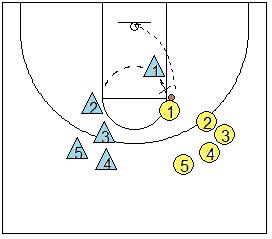 |
Two on Two Rebounding
This rebounding drill stresses the basics of boxing out,
being aggressive, and making the outlet pass, and "finishing" on the
offensive glass.
Setup: See the diagram... two rows, one on each
side of the free throw lane. The first player in each line becomes a
defender and moves down by the blocks and will box-out the next player
in line. The next player in each line are offensive players. Have a
player at each wing for the outlet pass. The coach, or manager, shoots
the ball from the free-throw line.
The Drill:
The coach shoots. The defenders box-out, rebound, make the outlet pass and the next group takes over. The two defenders rotate to the outlet positions, and the outlet players go to the back of the offensive lines. |
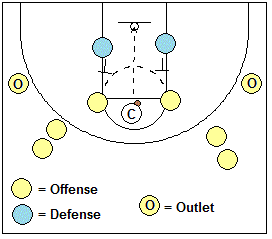 |
Offensive players should be aggressive, try to get the
offensive rebound, and power it back up to the hoop. Play until either
the defense rebounds and outlet passes, or the offense rebounds and
scores (limit offensive possessions to 6 seconds to keep the drill
moving). Then rotate to the next group. Offensive players now are
defenders.
Make sure all players hustle, are aggressive and are using good rebounding technique with proper boxing out, attacking the ball, and making a good outlet pass.
Make sure all players hustle, are aggressive and are using good rebounding technique with proper boxing out, attacking the ball, and making a good outlet pass.
Offensive players should be aggressive and power
the ball back up to the hoop, scoring quickly (within 6 seconds).
You can also run this drill with just one line, one defender and one outlet receiver.
Sunday, July 1, 2012
Individual Skills Defense Drills
Stance Drill
In diagram A, we get all players lined up four or five across (depending on your number of players) in rows. In the stance drill, we have players maintain the correct defensive stance for one minute. We want the hands and arms up and out, and feet shoulder width apart, weight on the balls of the feet (not flat-footed), knees bent and butt out. Surprisingly, it is not easy for players to hold this position for 60 seconds, as arm and leg fatigue creep in. You must do this drill regularly to strengthen these muscles so that your defenders don't lose their defensive stance late in a possession. A zone defense looks "lazy" when players are tired, not sprinting, and hands are down. While players are holding this stance position, you can use this minute to talk to them about anything you want.Slides Drill
In diagram B, after doing the stance drill for one minute, we do slides from side to side, again maintaining a good defensive stance with arms out and up, weight on the balls of the feet, and using good footwork, without crossing our feet. Start with players chattering their feet in place. As the coach yells (or points) the instructions, "right" or "left", players slide accordingly and chattering again once they stop sliding. Make sure that when players slide, they do not lower their hands... hands should remain up and active. Do this for another minute.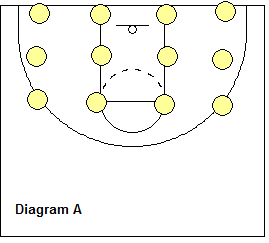
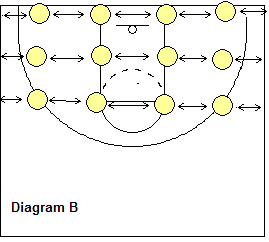
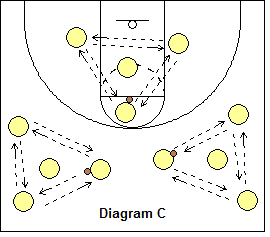
Triangle "Anticipation - Deflection" Drill
In diagram C, break the team down into 4-player groups. The player in the middle gets in the defensive stance (described above) and will try to anticipate and deflect the pass. After receiving the pass, the passer should hold the ball for a couple counts to allow the defender to get set, and can pass to either receiver. Do this drill so that each player gets 30-45 seconds of defending. This drill teaches defenders to read the passer and improves reaction time and quickness.Ball Pressure Drill
In diagram D, each player has a partner. The defender is an arm's length from the offensive player, and he/she pressures the ball-handler with active hands, but without reaching in and fouling. No dribbling is permitted, and the offensive player must use his/her pivoting skills to protect the ball. Do this for 30 seconds and have players switch offense <==> defense.Contain the Dribbler Drill
In diagram E, each player again has a partner. The defender is an arm's length from the offensive player, and he/she pressures the ball-handler with active hands, but without reaching in and fouling. Dribbling is now permitted, when the coach yells "go", the offensive player dribbles either left or right for a few steps, as the defender moves his/her feet quickly to contain the dribbler. Have the offensive player dribble to the right and to the left several times, and then switch offense <==> defense.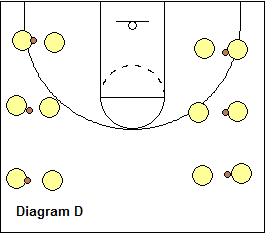
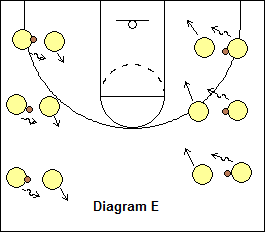
1-on-1 Full-Court Zig-Zag Drill
In diagram A below, each player has a partner of similar quickness and size. We use both sides of the floor and each two-some is confined to their side of the court. The offensive player tries to dribble the length of the court (staying on just half of the court), and attacks to score. The defensive player tries to cut and turn the offensive player as many times as he/she can coming up the court, and then defends 1-on-1 at the basket. The defender must get low and move his/her feet quickly. Hands should be active, but the defender must not reach in and foul (there is even a variation wherein the defensive player must keep his hands behind his back at all times). If the defender gets beaten, he/she must turn and sprint to recover.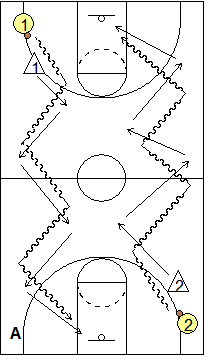
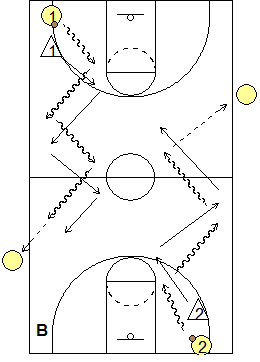
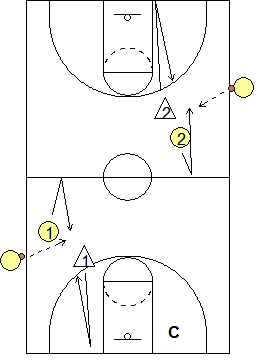
1-on-1 Full-Court Zig-Zag and Close-Out Drill
In diagrams B and C above, again each player has a partner of similar quickness and size. We use both sides of the floor and each two-some is confined to their side of the court. The offensive player tries to dribble beyond half-court and then passes to a coach standing out-of-bounds along the sideline. The defensive player tries to cut and turn the offensive player as many times as he/she can coming up the court. Once the pass is made to the coach on the sideline, the offensive player turns and sprints back to the half-court line and then back and receives the pass back from the coach (diagram C above), while the defensive player sprints to the endline and then back to close-out on the ball. Both players then finish by playing 1-on-1.Rotation and Close-Out Drills
The following drills help develop the necessary "habits" in rotating within the help defense, and closing out on the offense.On-Off Drill
In diagram F, as the ball is skip-passed to the left wing, X3 must first close-out with high hands, and then retreat back inside once X1 gets over to the ball. This is called going "on and off" for the forward defender (X3). Defenders should sprint quickly as the ball is in the air, as soon as it leaves the passer's hands. Close-out with high hands in a good defensive stance.Skip-Pass to Corner Drill
In diagram G, as the ball is skip-passed to the left corner, X3 must close-out with high hands and defend the ball. This is his/her man and X3 does not go "on and off" in the corner, but stays with the ball. X1 drops inside to prevent a pass to the lane or elbow. Defenders should sprint quickly as the ball is in the air, as soon as it leaves the passer's hands. X3 closes-out with high hands in a good defensive stance.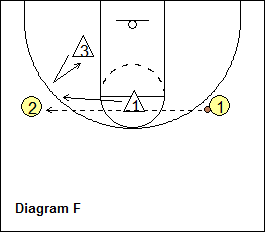
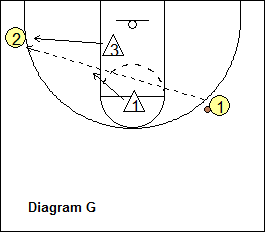
Forward's Wing and Corner Rotations Drill
Now we will drill how the outside low defender (forward) X4 defends the pass to the wing and to the corner. In diagram F2, as the ball is passed to the wing O2, X4 goes "on" (closes-out with high hands), and then retreats back inside ("off"). As the pass goes to the corner (diagram F3), X4 closes-out with high hands and stays with the ball in the corner. As the ball is passed back out to the wing O2 (diagram F4), X4 simply drops back inside, as normally X1 would already be on the ball O2 and there is no need to go "on and off" here.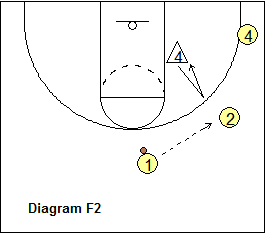
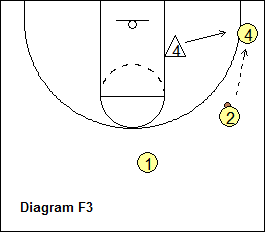
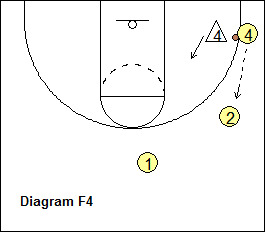
Forward's On-Off Rotations Drill
The next several diagrams H - K show how our two outside low defenders (forwards X3 and X4) rotate as the ball moves around on the perimeter. In diagram H, as the ball is passed from the point to the right wing, X4 goes "on and off" initially closing-out with high hands, and then retreating back inside. X3 moves inside the paint. As the ball is passed back to the point (diagram I), X3 moves back out to his/her usual neutral position.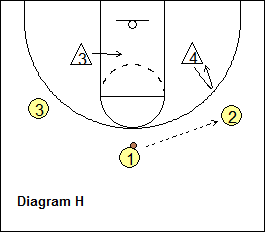
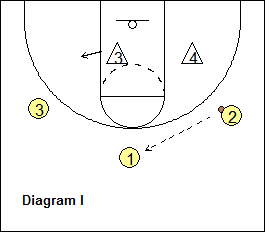
As the ball is passed from the point to the left wing (diagram J), X3 goes "on and off" initially closing-out with high hands, and then retreating back inside. X4 moves inside the paint. Diagram K shows a wing-to-wing skip-pass, with X4 going "on and off" and X3 dropping inside.
Spend a few minutes with the three offensive players passing the ball around on top while X3 and X4 rotate accordingly and quickly as the ball is in the air. In you have an assistant, use both ends of the court and make sure all of your inside defenders get enough repetitions.
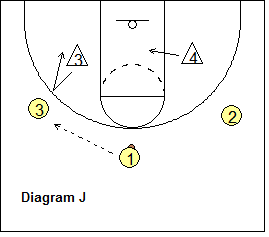
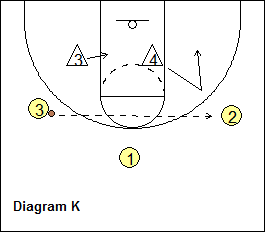
Basic pointers for all defenses
1. No lay-ups. Try to keep the ball outside. Double-team the ball in the paint.
1. No lay-ups. Try to keep the ball outside. Double-team the ball in the paint.
2. Be vocal, talk to each other.
3. Move quickly, adjust your position relative to the
movement of the ball. Move quickly on the flight of the ball, as soon
as it leaves the passer's hands.
4. Get your hands up and out, to shrink the passing lanes.
5. Close-out on the shooter with high hands, to pressure the shot and the pass. We are less concerned with dribble-penetration since the zone creates too much congestion inside for the dribble-drive.
6. Stay in your defensive stance. This is especially important for weakside defenders. The weakside low defender should keep his "butt to the baseline" so that he can see the floor, and see any cutters or screeners coming his way, etc.
7. No fouls... play good defense without fouling.
8. No second shots... be aggressive rebounders.
5. Close-out on the shooter with high hands, to pressure the shot and the pass. We are less concerned with dribble-penetration since the zone creates too much congestion inside for the dribble-drive.
6. Stay in your defensive stance. This is especially important for weakside defenders. The weakside low defender should keep his "butt to the baseline" so that he can see the floor, and see any cutters or screeners coming his way, etc.
7. No fouls... play good defense without fouling.
8. No second shots... be aggressive rebounders.
9. When the offense dribble penetrates, quickly close the gap.
10. Get to know your opponent and adjust. Over-protect
against the best shooters, or the "hot" shooter, and sag off the guy who
never shoots.
11. Trap the corners.
12. Especially if you are ahead, don't gamble or get
too zealous about trapping the wing and point guard positions. Keep
pressure on the ball, but also protect the paint and force the outside,
low-percentage shot.
Subscribe to:
Posts (Atom)